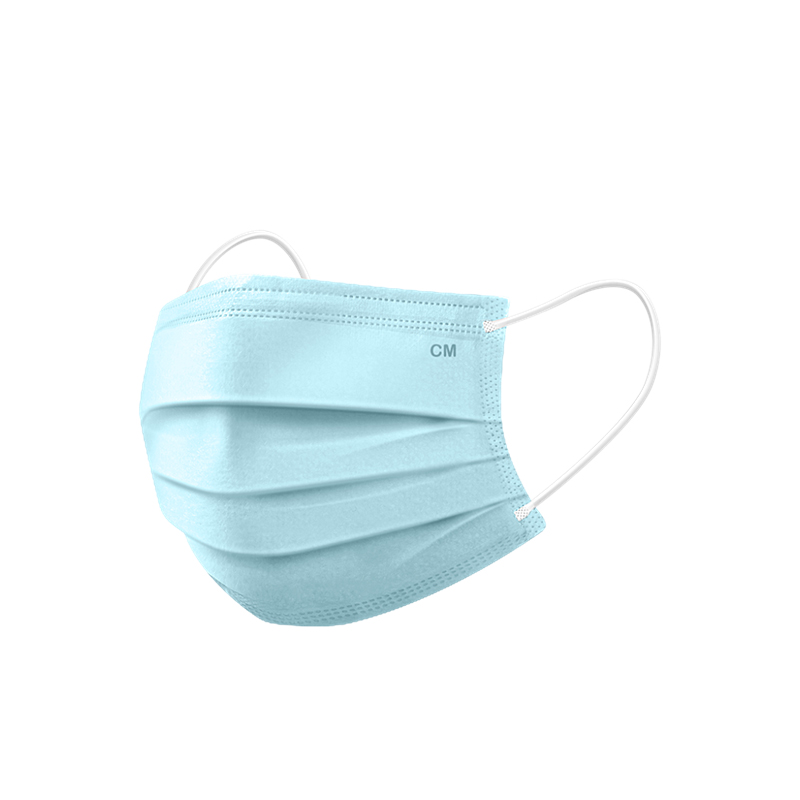
Surgical face mask (F-Y1-A Type IIR FDA510k)
Material composition
Filtering system is designed and layered by surface 25g non-woven, second layer 25g BFE99 filtration material, inner layer 25g non-woven.
Scope of application
It is used to cover the mouth, nose and jaw of the user, and provides a physical barrier to prevent the direct transmission of pathogenic microorganisms, body fluids, particles, etc.

F-Y1-A Type IIR FDA 510k is tested by Bacterial Filtration Efficiency (BFE) and Differential Pressure (Delta P), flammability of clothing textiles, Latex Particle Challenge, Synthetic Blood Penetration Resistance
Bacterial Filtration Efficiency (BFE) and Differential Pressure (Delta P)
Summary: The BFE test is performed to determine the filtration efficiency of test articles by comparing the bacterial control counts upstream of the test article to the bacterial counts downstream. A suspension of Staphylococcus aureus was aerosolized using a nebulizer and delivered to the test article at a constant flow rate and fixed air pressure. The challenge delivery was maintained at 1.7 – 3.0 x 103 colony forming units (CFU) with a mean particle size (MPS) of 3.0 ± 0.3 μm. The aerosols were drawn through a six-stage, viable particle, Andersen sampler for collection. This test method complies with ASTM F2101-19 and EN 14683:2019, Annex B.
The Delta P test is performed to determine the breathability of test articles by measuring the differential air pressure on either side of the test article using a manometer, at a constant flow rate. The Delta P test complies with EN 14683:2019, Annex C and ASTM F2100-19.
All test method acceptance criteria were met. Testing was performed in compliance with US FDA good manufacturing practice (GMP) regulations 21 CFR Parts 210, 211 and 820.
Flammability of clothing textiles
This procedure was performed to evaluate the flammability of plain surface clothing textiles by measuring the ease of ignition and the speed of flame spread. The parameter of time is used to separate materials into different classes, thereby assisting in a judgement of fabric suitability for clothing and protective clothing material. The test procedure was performed in accordance with the test method outlined in 16 CFR Part 1610 (a) Step 1 – testing in the original state. Step 2 – Refurbishing and testing after refurbishing was not performed. All test method acceptance criteria were met. Testing was performed in compliance with US FDA good manufacturing practice (GMP) regulations 21 CFR Parts 210, 211 and 820.
Latex Particle Challenge
Summary: This procedure was performed to evaluate the non-viable particle filtration efficiency (PFE) of the test article. Monodispersed polystyrene latex spheres (PSL) were nebulized (atomized), dried, and passed through the test article. The particles that passed through the test article were enumerated using a laser particle counter.
A one-minute count was performed, with the test article in the system. A one-minute control count was performed, without a test article in the system, before and after each test article and the counts were averaged. Control counts were performed to determine the average number of particles delivered to the test article. The filtration efficiency was calculated using the number of particles penetrating the test article compared to the average of the control values.
The procedure employed the basic particle filtration method described in ASTM F2299, with some exceptions; notably the procedure incorporated a non-neutralized challenge. In real use, particles carry a charge, thus this challenge represents a more natural state. The non-neutralized aerosol is also specified in the FDA guidance document on surgical face masks. All test method acceptance criteria were met. Testing was performed in compliance with US FDA good manufacturing practice (GMP) regulations 21 CFR Parts 210, 211 and 820.
Synthetic Blood Penetration Resistance
Summary: This procedure was performed to evaluate surgical facemasks and other types of protective clothing materials designed to protect against fluid penetration. The purpose of this procedure is to simulate an arterial spray and evaluate the effectiveness of the test article in protecting the user from possible exposure to blood and other body fluids. The distance from the target area surface to the tip of the cannula is 30.5 cm. A test volume of 2 mL of synthetic blood was employed using the targeting plate method.
This test method was designed to comply with ASTM F1862 and ISO 22609 (as referenced in EN 14683:2019 and AS4381:2015) with the following exception: ISO 22609 requires testing to be performed in an environment with a temperature of 21 ± 5°C and a relative humidity of 85 ± 10%. Instead, testing was performed at ambient conditions within one minute of removal from the environmental chamber held at those parameters.
All test method acceptance criteria were met. Testing was performed in compliance with US FDA good manufacturing practice (GMP) regulations 21 CFR Parts 210, 211 and 820.
A medical face mask (also known as surgical or procedure mask) is a medical device covering the mouth, nose and chin ensuring a barrier that limits the transition of an infective agent between the hospital staff and the patient. They are used by healthcare workers to prevent large respiratory droplets and splashes from reaching the mouth and the nose of the wearer and help reduce and/or control at the source the spread of large respiratory droplets from the person wearing the face mask. Medical face masks are recommended, as well, as a means of source control for persons who are symptomatic in order to prevent the spread of respiratory droplets produced by coughing or sneezing. The application of medical masks as source control has been shown to decrease the release of respiratory droplets carrying respiratory viruses.
The evaluation of conformity for surgical mask in USA is based, among other, upon the following standards and related requirements:
● Fluid Resistance Performance Test according to ASTM F1862 with synthetic blood: The test is considered passed with respect to a pressure value (80, 120 or 160 mmHg) if at least 29 out of 32 samples pass the test at a specified pressure. This test can be considered comparable with the Splash Resistance Pressure test described in EN 14683:2019;
● Bacterial Filtration Efficiency test according to ASTM F2101: the test is considered passed if BFE is ≥98%; the results of this test are comparable with the results of BFE test performed according to EN 14683:2019 ;
● Differential Pressure (Delta P) test according to MIL-M-36954C: the test is considered passed if the pressure difference ΔP is lower than 5 mmH2O/cm2. The results of this test are comparable with the results of the differential pressure test performed according to EN 14683:2019
● Biocompatibility evaluation performed according to ISO 10993-1:2018 “Biological evaluation of medical devices Evaluation and testing within a risk management process”. Surgical face mask may be categorized as surface medical device in contact with skin through a limited-contact (A, less than 24 hours) or prolonged contact (24 hours to 30 days) considering the cumulative application. According to this categorization, the biological endpoints to be assessed are cytotoxicity, irritation and sensitization together with chemical characterization as starting point for the evaluation








